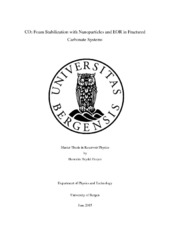| dc.contributor.author | Horjen, Henriette Trydal | eng |
| dc.date.accessioned | 2015-08-24T13:49:44Z | |
| dc.date.available | 2015-08-24T13:49:44Z | |
| dc.date.issued | 2015-06-18 | |
| dc.date.submitted | 2015-06-18 | eng |
| dc.identifier.uri | https://hdl.handle.net/1956/10353 | |
| dc.description.abstract | This thesis is a part of an ongoing study of CO2 foam mobility control in the Reservoir Physics group at the Department of Physics and Technology (IFT) at the University of Bergen. The goal of this thesis was to evaluate stabilization of foam and enhanced oil recovery (EOR) using hydrophilic silica nanoparticles and anionic AOS surfactants as foam agents. Foam was generated by co-injection of an aqueous foam agent solution and CO2 as the gaseous phase. Foam is generated in-situ as the two fluids are mixed in the porous medium, resulting in a mobility reduction of CO2. Miscible CO2 and CO2-foam injection tests using surfactants as a foaming agent were performed to study the effect on tertiary EOR in carbonate reservoirs. The experiments were conducted in strongly water-wet, fractured and un-fractured Edward limestone core plugs. Foam is used for mobility control by blocking high permeable zones, resulting in a delay of gas breakthrough and significantly improve the macroscopic sweep efficiency. Supercritical CO2 injections increased on average oil recovery by 20% OOIP compared to ordinary water injection. The highest recovery (63% OOIP) was obtained by first injecting supercritical CO2 followed by CO2-foam. Foam was generated in-situ in cores without fractures, verified by increased pressure drop. Foam generation in fractured was poor, mainly due to lack of generation sites, low stability and high oil saturation. The limited stability of surfactant-generated foam in presence of oil, combined with high reservoir temperature and high salinity are among reasons why foam is not being widely used as a common EOR method. Nanoparticles are reported to work as foam stabilizers and are chemically stable in a wider range of reservoir conditions than surfactants. Experimental investigations using nanoparticles as foaming agents, without the presence of oil, were therefore conducted in this thesis. The sensitivity in parameters such as gas fraction, total injection rate and injection strategies using nanoparticles to generate foam were investigated. The pressure drop across the core was measured to estimate the achieved mobility reduction factor (MRF) and the apparent viscosity of the generated foam. The result shows that independent of the gas fraction an increase in injection rate lead to a higher pressure drop. The apparent viscosity of the foam increased with higher gas fractions for some, but not all injections. The inconsistency is caused by a significant hysteresis effect. Common for the injection experiments is that high liquid or high gas fraction generates foam with a lower apparent viscosity. | en_US |
| dc.format.extent | 3776213 bytes | eng |
| dc.format.mimetype | application/pdf | eng |
| dc.language.iso | eng | eng |
| dc.publisher | The University of Bergen | en_US |
| dc.rights | Copyright the Author. All rights reserved | eng |
| dc.subject | Skum | nob |
| dc.subject | Økt oljeutvinning | nob |
| dc.title | CO2 Foam Stabilization with Nanoparticles and EOR in Fractured Carbonate Systems | en_US |
| dc.type | Master thesis | |
| dc.description.localcode | MAMN-PETR | |
| dc.description.localcode | PTEK399 | |
| dc.subject.realfagstermer | http://data.ub.uio.no/realfagstermer/c007418 | |
| dc.subject.realfagstermer | http://data.ub.uio.no/realfagstermer/c031431 | |
| dc.subject.nus | 752223 | eng |
| fs.subjectcode | PTEK399 | |
